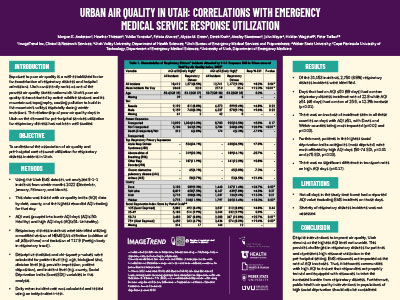ABSTRACTS
Urban Air Quality in Utah: Correlations with EMS Response UtilizationAuthor: Morgan K. Anderson, Heather Thiesset, Yukiko Yoneoka, Felicia Alvarez, Alyssa M. Green, Derek Kraft, Ainsley Stoneman, John Meyer, Holden Wagstaff, and Peter Taillac | | Associate Authors:
Introduction: Utah consistently ranks as one of the worst air quality locations in the United States. Utah’s poor air quality is exacerbated by wildfire seasons and its mountainous topography, causing pollution to build in the mountains’ valleys. The impact of poor air quality days in Utah on the demand for prehospital services and resource utilization for respiratory distress (RD) calls has not been well studied. Objective: To understand the burden on prehospital care resource utilization from RD exacerbated by poor air quality in Utah. Methods: Using the Utah EMS dataset, we analyzed 9-1-1 incidents from winter months in 2022 (December, January, February, and March) in urban counties. This data was linked with Air Quality Index (AQI) data by date, county, and the highest recorded daily AQI reading. AQI was grouped into lower-AQI days (AQI ≤ 50) and high-AQI days (AQI ≥ 51). RD incidents were identified utilizing a modified version of NEMSQA’s definition (addition of all J45 [asthma] and exclusion of T17.9 [foreign body in respiratory tract]). We examined patient-level (e.g., age, biological sex), clinician-level (e.g., provider impression, patient disposition), and incident-level (e.g., county, Social Deprivation Index Score [SDI]) variables. Results: Of the 31,153 incidents, 2750 (8.8%) RD incidents were identified. Days that had an AQI ≤ 50 (69 days) had a mean RD incidence rate of 22.8, whereas AQI ≥ 51 (46 days) had a mean of 25.6, a 12.3% increase. An increase in incidence of RD was seen in all counties on days with AQI ≤ 50, with Davis and Weber counties being most impacted (p = .02 and p = .03, respectively). Furthermore, patients in the highest SDI categories (most deprived) were most affected by high-AQI days (50–74 SDI, p = .01, and 75+ SDI, p = .03). No significant difference was found in transport rates on high-AQI days (p = .17). Conclusion: This study found that RD incidents attended by EMS increase with increases in AQI. Communities with high AQI should ensure that responders are properly trained and equipped with resources to treat the increased burden from RD. Furthermore, public health interventions in populations of high social deprivation should also be considered to promote prevention and ensure access to care.
|

